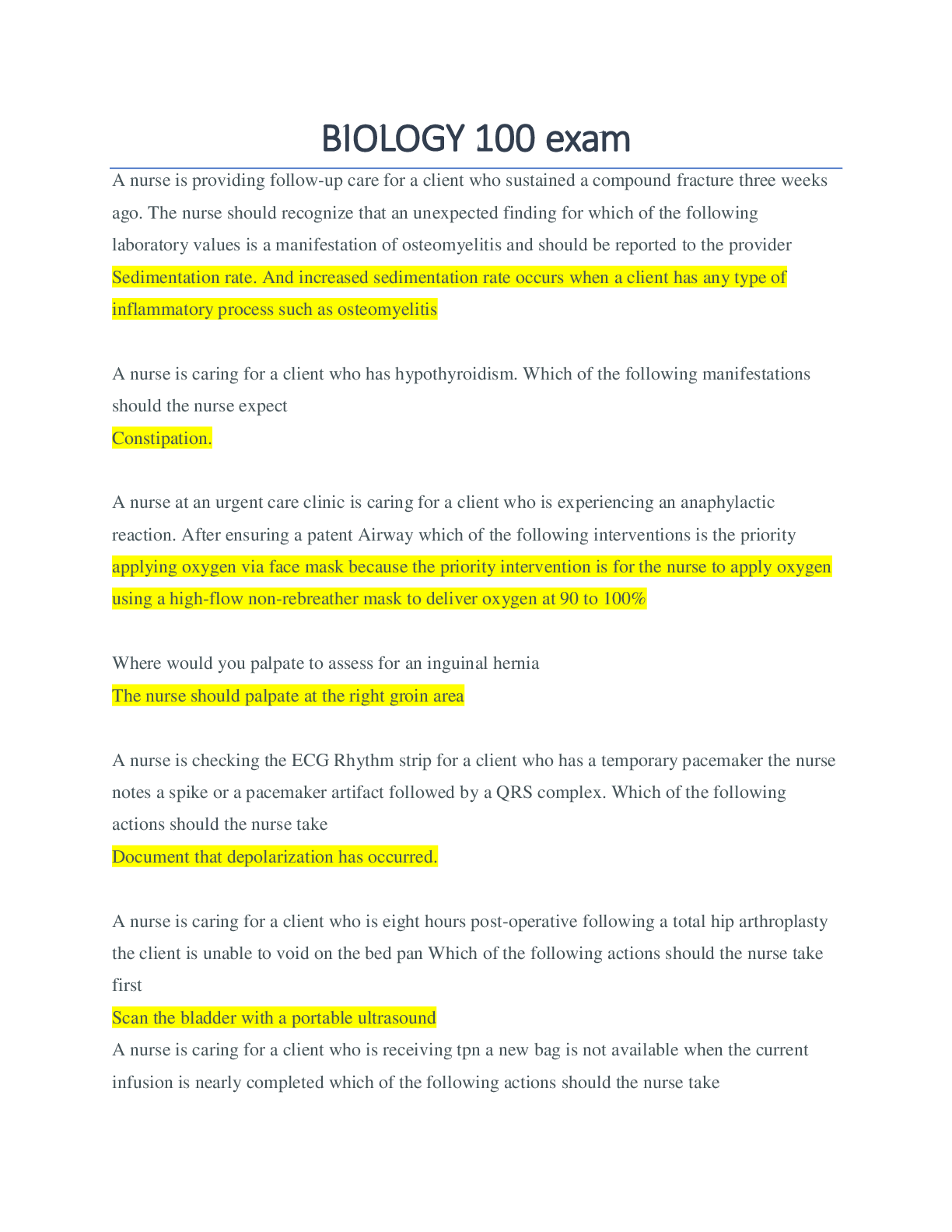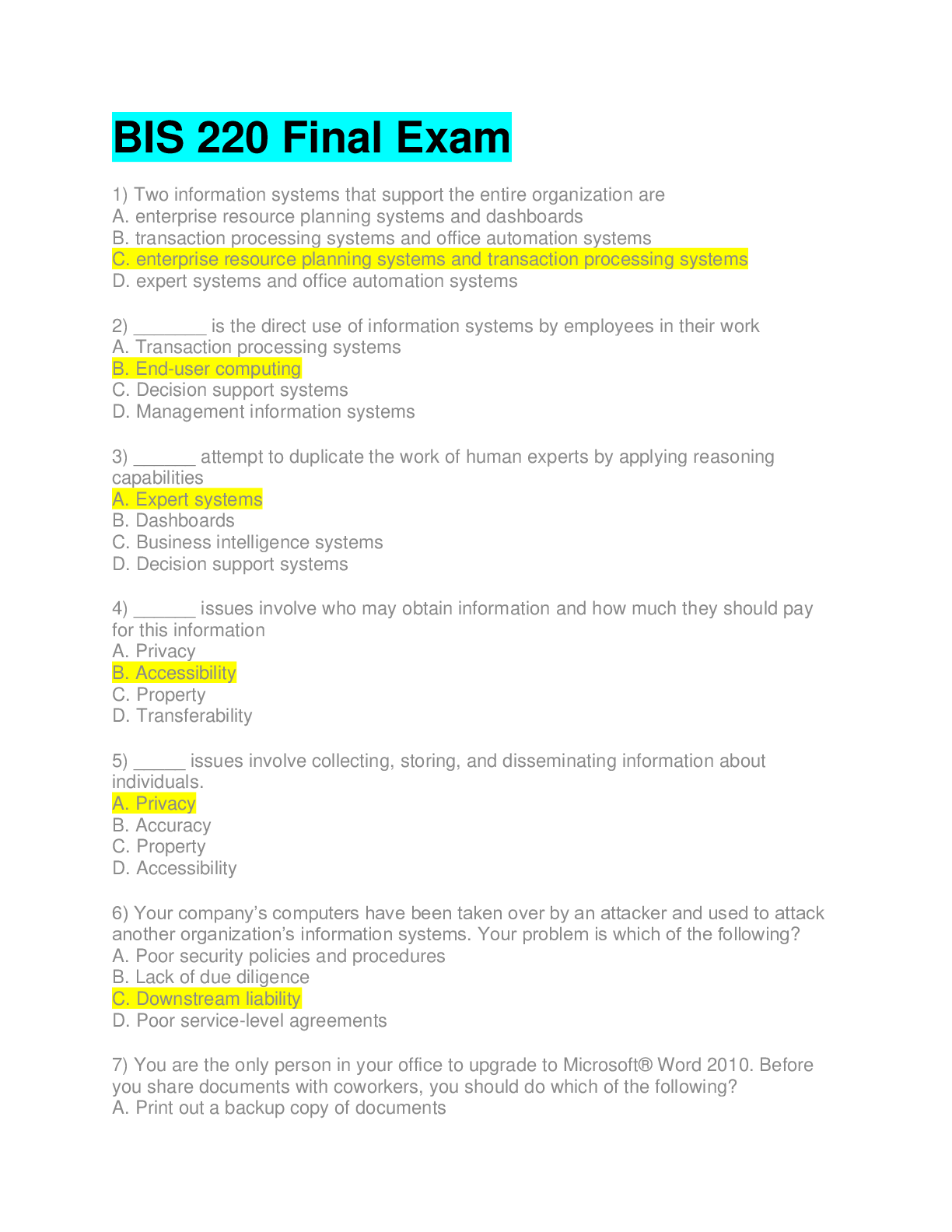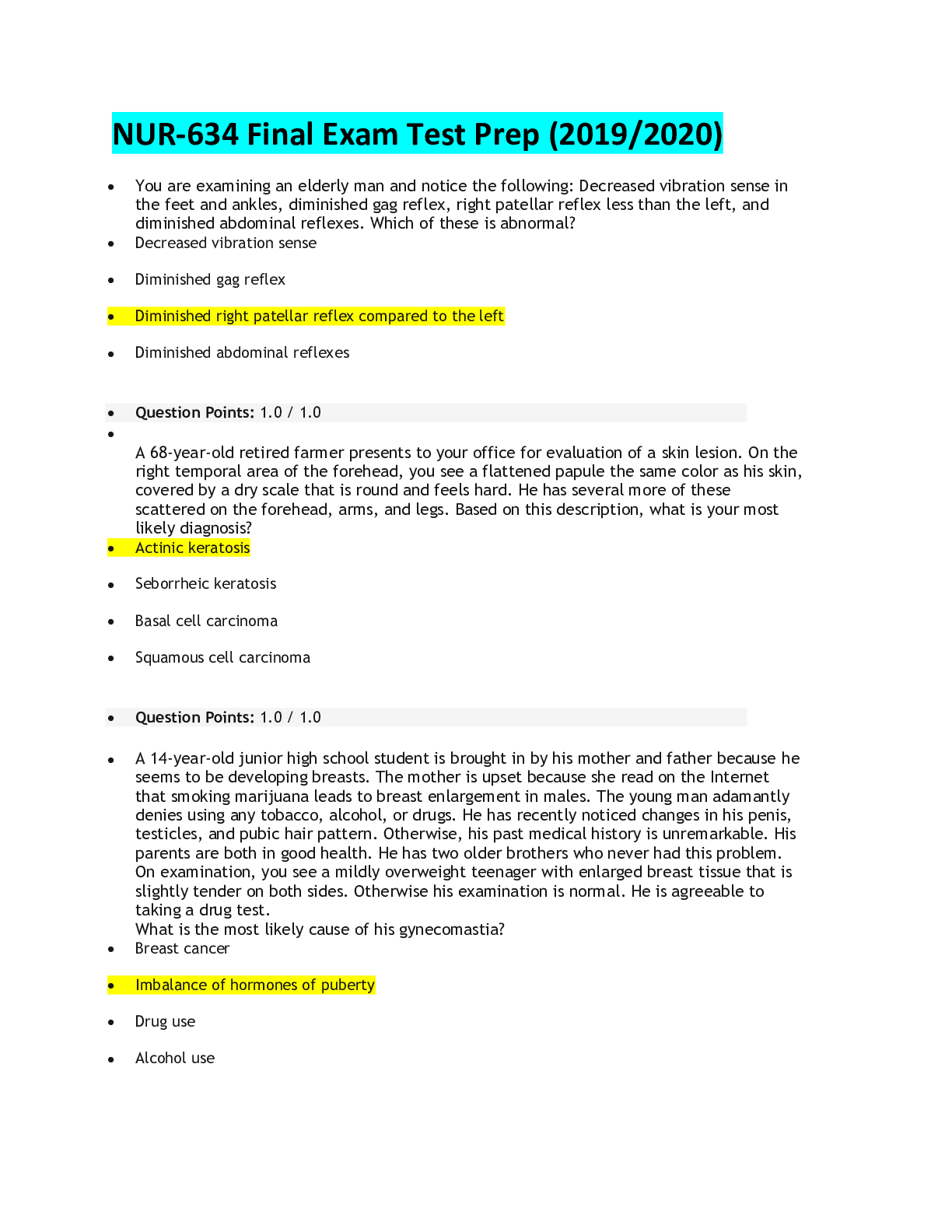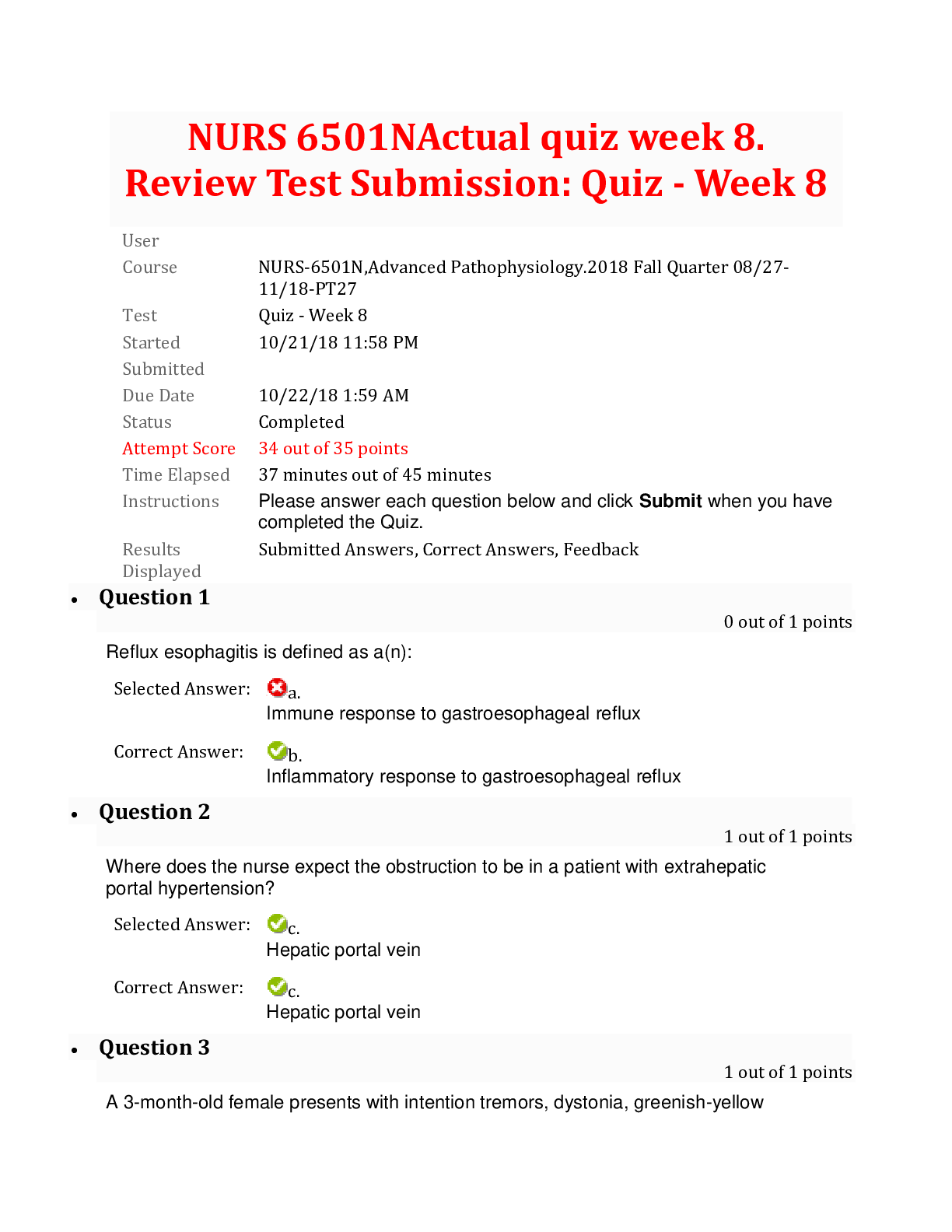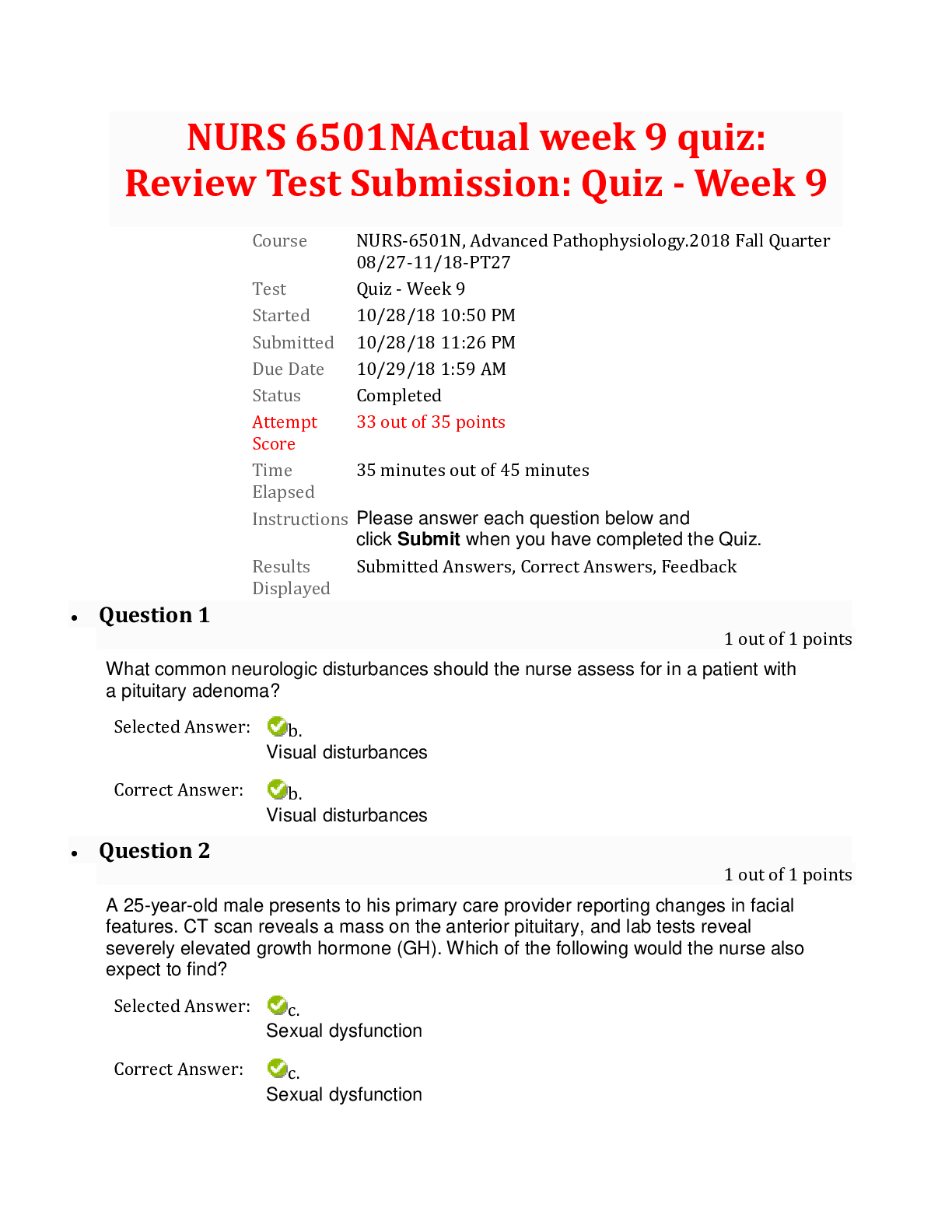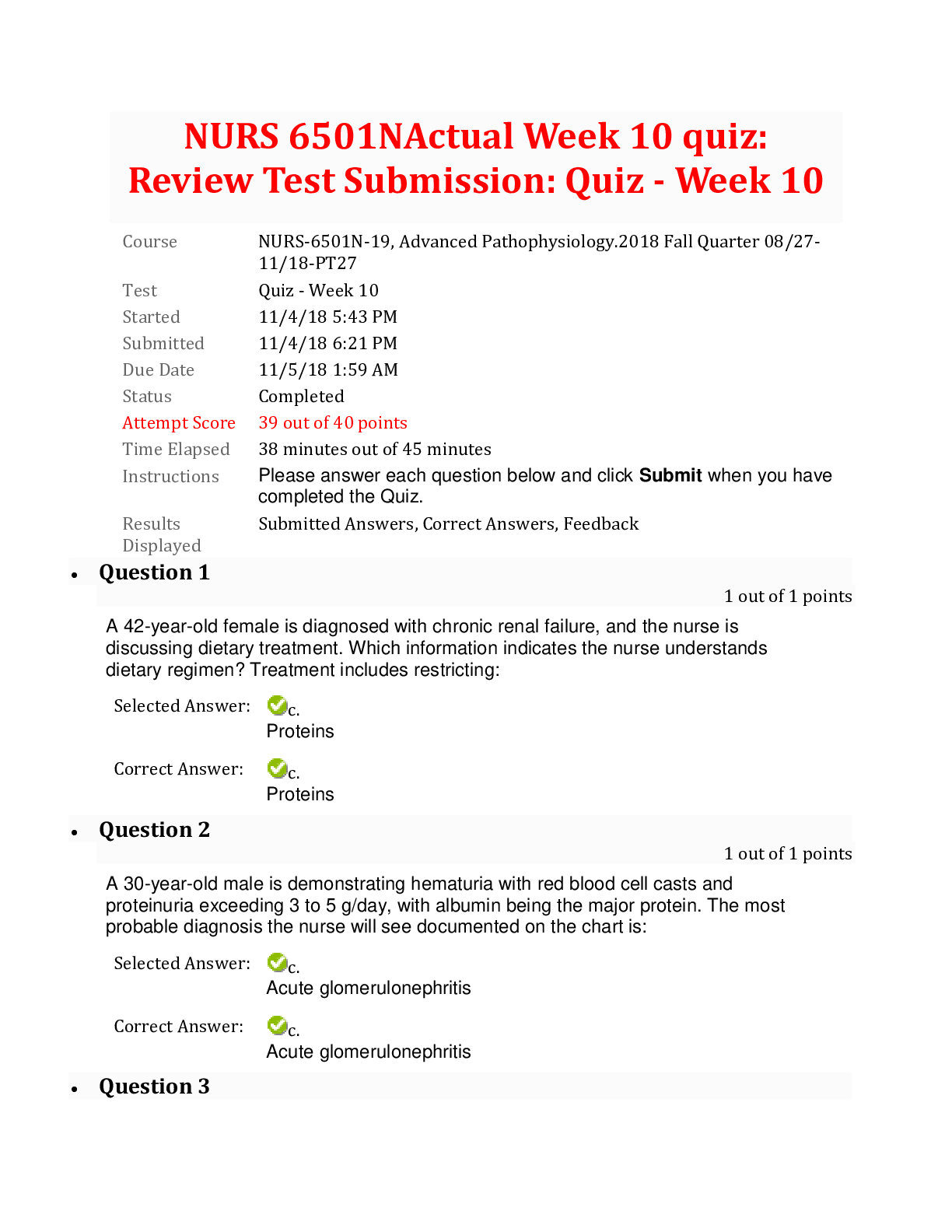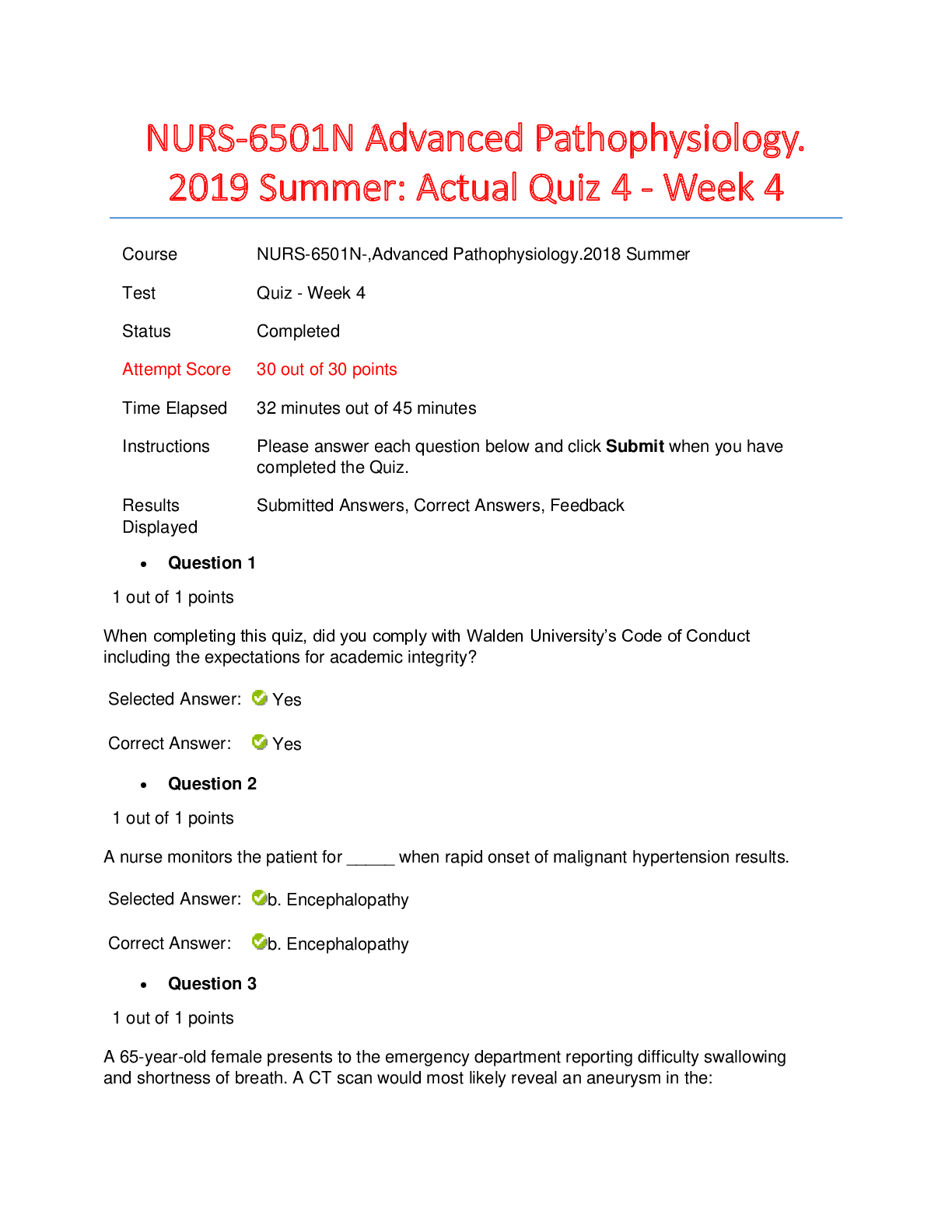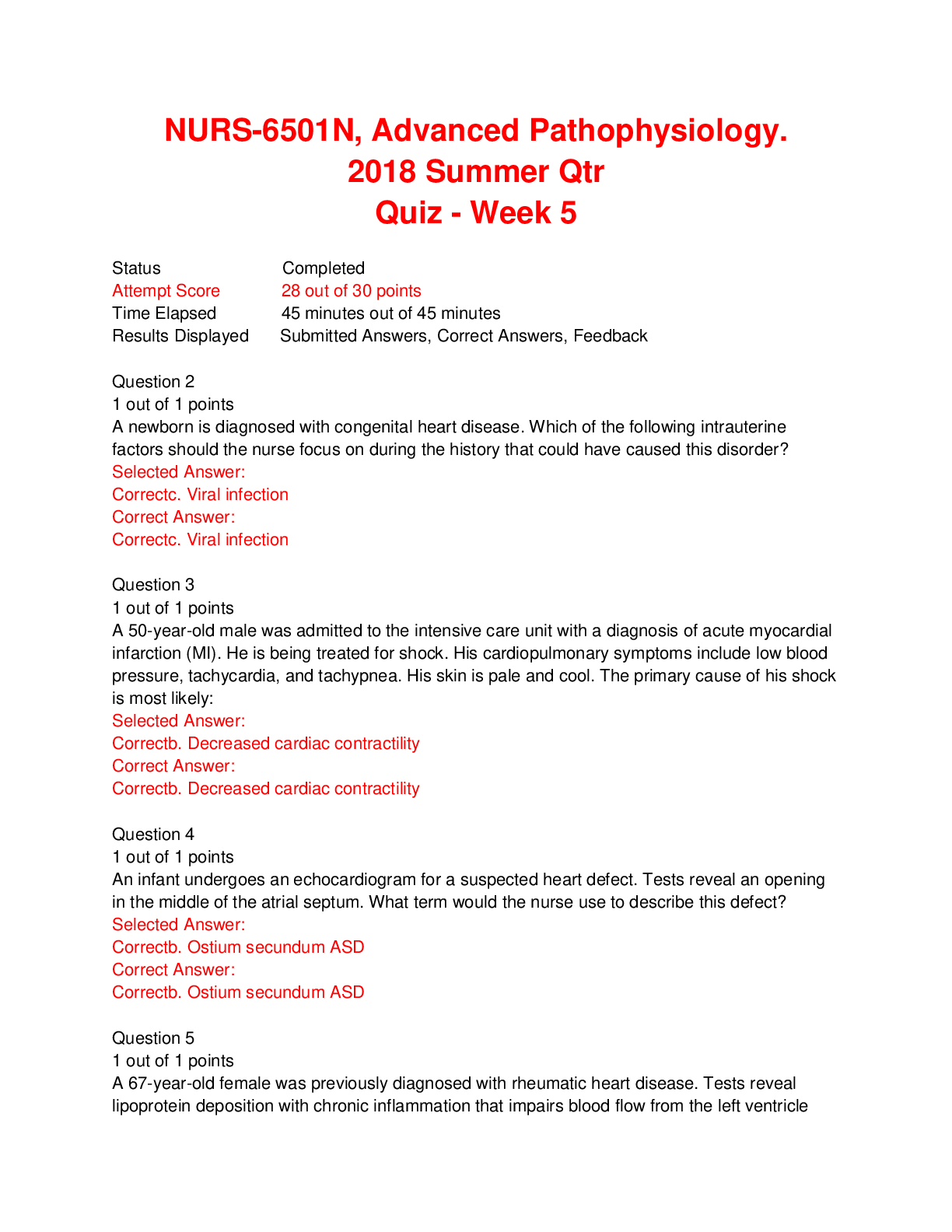*NURSING > QUESTIONS & ANSWERS > EMT Old Final Exam Questions 100 questions with 100% correct answers (All)
EMT Old Final Exam Questions 100 questions with 100% correct answers
Document Content and Description Below
EMT Old Final Exam Questions 100 questions with 100% correct answers 1. A young female presents with costovertebral angle tenderness. She is conscious and alert with stable vital signs. Which of th... e following organs is MOST likely causing her pain? A) Liver B) Kidney C) Pancreas D) Gallbladder 2. A patient whose speech is slurred and difficult to understand is experiencing: A) aphasia. B) dysarthria. C) dysphagia. D) paraplegia. 3. Dyspnea is MOST accurately defined as: A) shortness of breath or difficulty breathing. B) a complete cessation of respiratory effort. C) a marked increase in the exhalation phase. D) labored breathing with reduced tidal volume. 4. Which of the following questions would you ask a patient to ascertain the “M” in the SAMPLE history? A) “Have you ever had any major surgeries?” B) “How long have you had your chest pain?” C) “How much Tylenol do you take each day?” D) “When was the last time that you ate a meal?” 5. When palpating a patient's pulse, you note that it is grossly irregular. You should: A) count the pulse rate for at least 30 seconds to ensure accuracy. B) count the number of pulsations in 15 seconds and multiply by 4. C) count the number of pulsations in 30 seconds and multiply by 2. D) count the pulse rate for a full minute to obtain an accurate reading. 6. Which of the following statements regarding hemophilia is MOST correct? A) Hemophilia is defined as a total lack of platelets. B) Patients with hemophilia may bleed spontaneously. C) Hemophiliacs take aspirin to enhance blood clotting. D) Approximately 25% of the population has hemophilia. 7. Which of the following medications blocks the release of histamines? A) Adrenaline B) Epinephrine C) DiphenhydramineD) Acetaminophen8. You are attempting to resuscitate a 50-year-old male in cardiac arrest. He is on the second floor of his home. What is the MOST appropriate device to use when carrying him to the first floor? A) Long backboard B) Wheeled stretcher C) Folding stair chair D) Portable stretcher 9. Which of the following statements regarding abdominal eviscerations is MOST correct? A) Most eviscerations occur to the left upper quadrant. B) The protruding organs should be kept warm and moist. C) The organs should carefully be replaced to avoid heat loss. D) Adherent material is preferred when covering an evisceration. 10. Index of suspicion is MOST accurately defined as: A) the way in which traumatic injuries occur. B) a predictable pattern that leads to serious injuries. C) concern for potentially serious underlying injuries. D) the detection of less obvious life-threatening injuries. 11. A nuchal cord is defined as an umbilical cord that: A) has separated from the placenta. B) is wrapped around the baby's neck. C) is lacerated due to a traumatic delivery. D) has abnormally developed blood vessels. 12. When caring for a patient who takes numerous medications, it is best to: A) document the medications on your patient care report, but leave them at home so they do not get misplaced. B) take all of the patient's medications with you to the hospital and document them on your patient care report. C) send the patient's medications to the hospital with a family member or other person who will safeguard them. D) let the hospital staff retrieve the patient's medical records, which should show a list of his or her current medications. 13. In contrast to a behavioral crisis, a psychiatric emergency occurs when a person: A) demonstrates agitation or violence or becomes a threat to self or others. B) experiences feelings of sadness and despair for greater than one month. C) exhibits impaired functioning due to a chemical or genetic disturbance. D) experiences a sudden attack of panic secondary to a stressful situation.14. Once a cervical collar has been applied to a patient with a possible spinal injury, it should not be removed unless: A) the patient adamantly denies neck pain. B) lateral immobilization has been applied. C) it causes a problem managing the ABCs. D) sensory and motor functions remain intact. 15. Shock is the result of: A) hypoperfusion to the cells of the body. B) the body's maintenance of homeostasis. C) temporary dysfunction of a major organ. D) widespread constriction of the blood vessels. 16. The is a prominent bony mass that is located at the base of the skull and posterior to the ear. A) orbital socket B) sphenoid fossa C) zygomatic arch D) mastoid process 17. Pelvic inflammatory disease (PID) is an infection of the: A) testicles. B) gallbladder. C) urinary bladder. D) fallopian tubes. 18. Ketone production is the result of: A) acidosis when blood glucose levels are low. B) blood glucose levels higher than 120 mg/dL. C) fat metabolization when glucose is unavailable. D) rapid entry of glucose across the cell membrane. 19. Your partner, a veteran EMT-B who you have worked with regularly for the past 4 years, seems unusually agitated during a call involving an elderly patient. Upon arrival back at your station, you note the obvious smell of alcohol on his breath. What should you do? A) Remain quiet and simply request another partner. B) Report the incident to your EMS medical director. C) Discreetly report your suspicions to your supervisor. D) Tell your partner that he must seek professional help.20. You respond to an office building to find a middle-aged male in cardiac arrest. Coworkers are performing CPR and state that the patient has been down for approximately 10 minutes. You attach the AED, push the analyze button, and receive a “shock advised” message. You should: A) ensure that nobody is touching the patient and then defibrillate. B) continue CPR for 1 minute and reanalyze the patient's rhythm. C) transport immediately and request a paramedic unit rendezvous. D) call medical control and request permission to stop resuscitation. 21. Vesicant agents include all of the following, EXCEPT: A) sarin. B) lewisite. C) sulfur mustard. D) phosgene oxime. 22. You are dispatched to the county jail for an inmate that is “sick.” When you arrive, you find the patient, a 33-year-old male, unresponsive. His airway is patent and his respirations are rapid and shallow. Your initial action should be to: A) apply a pulse oximeter. B) request a paramedic unit. C) provide assisted ventilation. D) obtain his blood pressure. 23. The MOST serious complication associated with using a nasopharyngeal airway in a patient with head trauma is: A) fracturing the septum. B) damaging the turbinates. C) penetrating the cranium. D) causing severe bleeding. 24. Braxton-Hicks contractions are characterized by: A) regular contractions of progressively increasing intensity. B) alleviation of pain with movement or changing positions. C) pink or red bloody show in conjunction with the contractions. D) a rupture of the amniotic sac just before the contractions begin. 25. Eclampsia is MOST accurately defined as: A) high levels of protein in the patient's urine. B) hypertension in the 20th week of pregnancy. C) seizures that result from severe hypertension. D) a blood pressure greater than 140/90 mm Hg. 26. In addition to external bleeding, the MOST significant risk that an open soft tissue injury exposes a patient to is:A) infection. B) hypothermia. C) nerve damage. D) vessel damage. 27. You are treating a man with a closed head injury following an assault by a burglar. The patient, who has slurred speech, becomes verbally abusive and tells you to "leave him alone." You should: A) ask a police officer to transport the patient to the hospital. B) allow him to refuse treatment since the injury was not his fault. C) proceed with treatment and utilize law enforcement if necessary. D) have the police arrest him so that you can legally begin treatment. 28. The ONLY indications for placing your gloved fingers in the vagina during delivery are: A) breech presentation and prolapsed umbilical cord. B) limb presentation and severe vaginal hemorrhage. C) vertex presentation and delivery of the placenta. D) nuchal cord and presentation of an arm or leg. 29. Which of the following statements regarding stridor is MOST correct? A) It is a whistling sound heard in the lower airway. B) Stridor is caused by incorrect airway positioning. C) It is a high-pitched, crowing upper airway sound. D) Stridor suggests the presence of fluid in the lungs. 30. Delirium tremens (DTs) is a syndrome associated with withdrawal from: A) cocaine. B) opioids. C) alcohol. D) sedatives. 31. The purpose of a “jump kit” is to: A) facilitate defibrillation within 5 to 10 minutes after making patient contact. B) manage a critically injured patient until he or she is loaded into the ambulance. C) carry advanced life support equipment approved by the EMS medical director. D) contain anything that you might need during the first 5 minutes of patient care. 32. Infection should be considered as a possible cause of an airway obstruction in an infant or child, especially if he or she presents with: A) severe restlessness. B) drooling or congestion. C) skin that is cool and dry. D) acute respiratory distress.33. Pain felt at a location other than its origin is called: A) referred pain. B) radiating pain. C) visceral pain. D) remote pain. 34. While using lights and siren, most state laws permit an ambulance to: A) disregard all traffic control signals. B) drive as fast as the department allows. C) carefully exceed the posted speed limit. D) proceed through red lights without stopping. 35. The officer is responsible for notifying area hospitals and determining their availability and capabilities. A) triage [Show More]
Last updated: 5 months ago
Preview 1 out of 17 pages
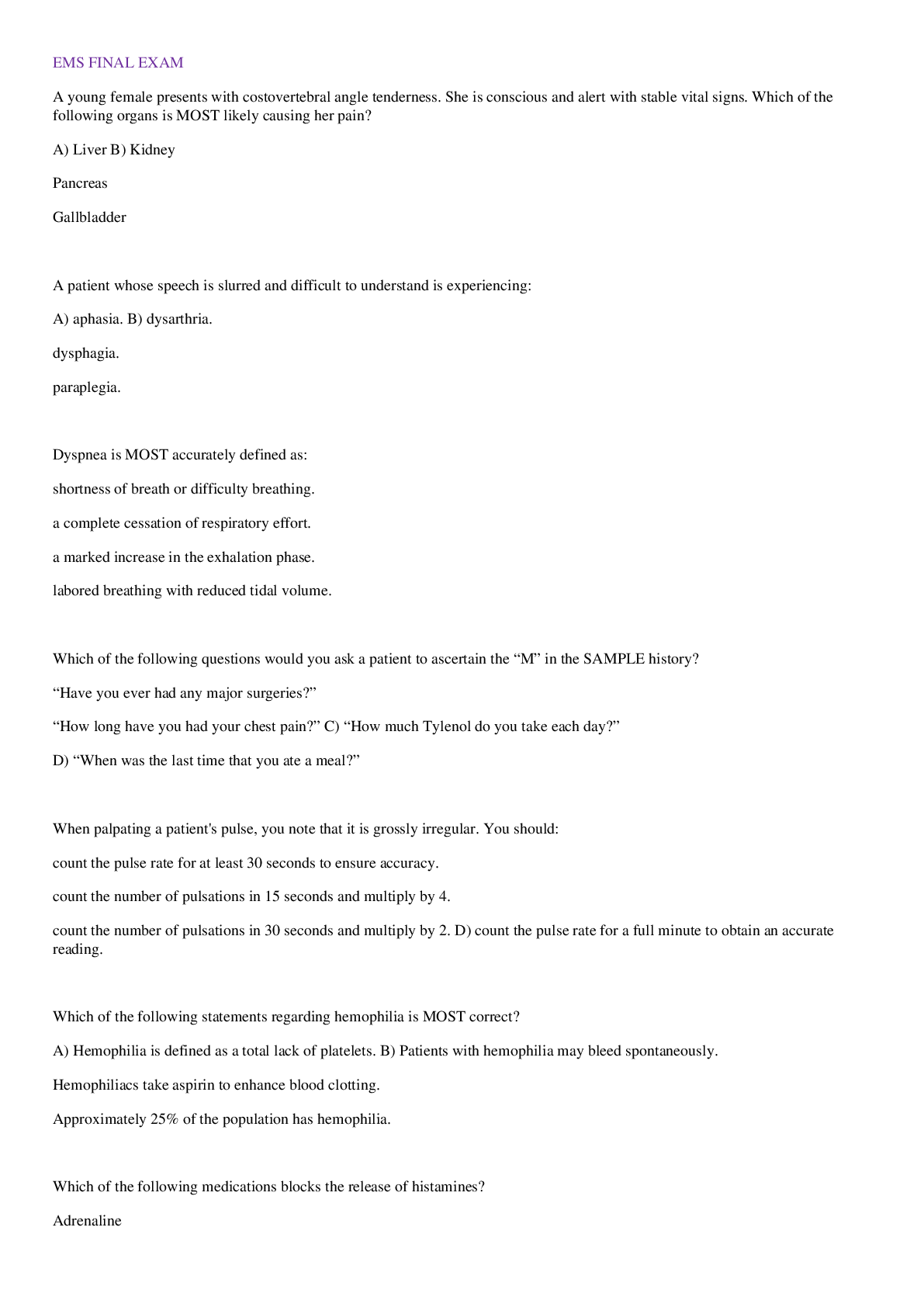
Buy this document to get the full access instantly
Instant Download Access after purchase
Buy NowInstant download
We Accept:

Also available in bundle (1)

THE EMT BUNDLE, QUESTIONS WITH ACCURATE ANSWERS,
Comprises of all EMT documents, Questions and answers, Graded A+
By bundleHub Solution guider 2 years ago
$50
37
Reviews( 0 )
$16.00
Can't find what you want? Try our AI powered Search
Document information
Connected school, study & course
About the document
Uploaded On
Aug 24, 2022
Number of pages
17
Written in
Seller

Reviews Received
Additional information
This document has been written for:
Uploaded
Aug 24, 2022
Downloads
0
Views
297











